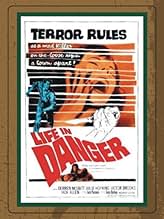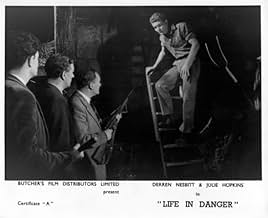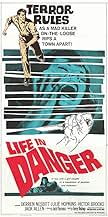IMDb-BEWERTUNG
6,3/10
227
IHRE BEWERTUNG
Füge eine Handlung in deiner Sprache hinzuThe inhabitants of a small village, led by a war veteran, try to catch a vagrant, who they suspect to be an escaped mental patient.The inhabitants of a small village, led by a war veteran, try to catch a vagrant, who they suspect to be an escaped mental patient.The inhabitants of a small village, led by a war veteran, try to catch a vagrant, who they suspect to be an escaped mental patient.
Howard Marion-Crawford
- Major Peters
- (as Howard Marion Crawford)
Joe Beckett
- Police Dispatcher
- (Nicht genannt)
Jim Morris
- Police Constable
- (Nicht genannt)
Ernie Rice
- Man in Armed Group
- (Nicht genannt)
Empfohlene Bewertungen
A terse, compelling rural drama, probably inspired by the Straffen case that shocked Britain a few years earlier; plus forties dramas about small-town xenophobia like 'The Ox-Bow Incident' and 'Panique' (Howard Marion Crawford as Major Peters strongly recalling Harry Shannon as Major Tetley in the former).
A young Derren Nesbitt demonstrates that once long ago he could touchingly play waifs as well as bullies.
A young Derren Nesbitt demonstrates that once long ago he could touchingly play waifs as well as bullies.
Virtually unknown British film which deals with an escaped prisoner from an asylum and the paranoia this causes in the local community.
Parkways is the institution which dominates the area - a siren is sounded when there is a possible escapee and stops everybody in their tracks, causing instant panic. The story introduces the small-town characters, who have become short-sighted and mistrustful because of the presence of the asylum. One typical character, the Major, talks about hunting game in Burma, and how escaped lunatics should be dealt with in similar fashion.
Having set the scene, the narrative unfolds with a young man drifting through town, the day after an escape from Parkways. He befriends a young boy and a teenage girl and the stage is set for confrontation, with the audience unsure who their sympathies should be with.
This really is a solid effort and makes one realise that Britain has its own sub-culture of commendable B-Movies from the '50s and '60s. Director Terry Bishop's next film was the even-more impressive 'Cover Girl Killer' (1959), which seems to be equally unheard of.
Derren Nesbitt is good in the lead role - looking like a young cross between Paul Newman and Rutger Hauer - and the film is well above-average, with an intelligent, tight storyline. Explores similar themes to 'The Ox-Bow Incident' (1943).
Parkways is the institution which dominates the area - a siren is sounded when there is a possible escapee and stops everybody in their tracks, causing instant panic. The story introduces the small-town characters, who have become short-sighted and mistrustful because of the presence of the asylum. One typical character, the Major, talks about hunting game in Burma, and how escaped lunatics should be dealt with in similar fashion.
Having set the scene, the narrative unfolds with a young man drifting through town, the day after an escape from Parkways. He befriends a young boy and a teenage girl and the stage is set for confrontation, with the audience unsure who their sympathies should be with.
This really is a solid effort and makes one realise that Britain has its own sub-culture of commendable B-Movies from the '50s and '60s. Director Terry Bishop's next film was the even-more impressive 'Cover Girl Killer' (1959), which seems to be equally unheard of.
Derren Nesbitt is good in the lead role - looking like a young cross between Paul Newman and Rutger Hauer - and the film is well above-average, with an intelligent, tight storyline. Explores similar themes to 'The Ox-Bow Incident' (1943).
Another Derren Nesbitt sleeper. Not so good as The Man In the Back Seat
maybe, but this is still a reasonably taut British thriller which grows in stature as it goes along. Nesbitt plays the suspected maniac on the loose, eventually cornered in a hayloft after befriending children (shades of Whistle Down the Wind here) What makes this film interesting, besides Nesbitt's presence in a starring role, is the way in which the narrative plays with our genre expectations, eventually forming a critique of 'respectable' society rather than providing the predictable portrait of a loser on the run. Both Nesbitt and Julie Hopkins (in one of her few screen roles) do a good job, while the film does a subtle job of juxtaposing the world of the pub with the freedom represented by the barn. It is the gradual rediscovery of low budget efforts like these, directed by a small and often overlooked cadre of second or third-rankers, often with a cast of familiar faces, which puts the lie to the idea that for much of this time Britain was a land without cinema. Maybe it was just not the cinema that some critics were looking for, since this sort of unassuming film these days gives more immediate pleasure than some of the stuffy quality productions of the time, If this and its ilk were in French no doubt we would be hearing more about them.
The fact that there are only 2 other reviews testify to the fact that this is virtually unknown.Yet it is an exciting,thoughtful and well made film with an excellent cast.Derren Nesbitt is especially good particularly since in some ways he is playing against type.There seem to be so many threads and characters running through this film that it is difficult to realise that it runs just over an hour.One gets the feeling that Butcher's spent the absolute minimum on this film,though they still manage to get a reasonable standard of production out of it.The film made a welcome return to the TV screen with its recent showing on Talking Picture TV.
At an institute for the criminally insane. The Governor is deciding whether to sound the alarm that a potentially dangerous inmate has escaped.
While he decides, the clock is ticking down. The inmate is getting further away making it harder for the police to catch him quickly.
Derren Nesbitt is the rough looking casual labourer who has come to a small village looking for work. He has a tattoo on his hand.
The stranger has no money until a woman at a bus stop gives him a few coins. The local pub does not serve him as he looks like a vagrant.
Hazel is a young woman who takes pity on the stranger. She directs him to a barn where he could rest. Later Hazel joins him with her brother.
Back at the village, once news emerges of the escaped inmate.
Major Peters does not want to leave matter to the police. He incites the villagers to become vigilantes and take the law into their own hands.
Realising that Hazel might be with a dangerous convict. They surround the barn, the escaped inmate has a tattoo on his hand.
Life In Danger is a low budget B movie. An escaped convict in a barn with some kids, that would be the more famous Whistle Down the Wind with Alan Bates which came out in 1961.
This movie is a contrived morality tale weighed down by its low budget somewhat.
The screenplay by Malcolm Hulke and Eric Paice was laboured, even the twist at the end looked out of place.
While he decides, the clock is ticking down. The inmate is getting further away making it harder for the police to catch him quickly.
Derren Nesbitt is the rough looking casual labourer who has come to a small village looking for work. He has a tattoo on his hand.
The stranger has no money until a woman at a bus stop gives him a few coins. The local pub does not serve him as he looks like a vagrant.
Hazel is a young woman who takes pity on the stranger. She directs him to a barn where he could rest. Later Hazel joins him with her brother.
Back at the village, once news emerges of the escaped inmate.
Major Peters does not want to leave matter to the police. He incites the villagers to become vigilantes and take the law into their own hands.
Realising that Hazel might be with a dangerous convict. They surround the barn, the escaped inmate has a tattoo on his hand.
Life In Danger is a low budget B movie. An escaped convict in a barn with some kids, that would be the more famous Whistle Down the Wind with Alan Bates which came out in 1961.
This movie is a contrived morality tale weighed down by its low budget somewhat.
The screenplay by Malcolm Hulke and Eric Paice was laboured, even the twist at the end looked out of place.
Wusstest du schon
- WissenswertesFor Derren Nesbitt, this film was one of his first "leading man" roles.
- PatzerWhen Derren Nesbitt and Julie Hopkins hide in the hay loft police tracker dogs are unable to detect them, though in real life such dogs would have no difficulty in sniffing out a human presence however well hidden.
- Zitate
Jill Shadwell: I wonder how many of them are ever cured?
Major Peters: Cured? My dear, they're criminal lunatics - they're little better than brutes.
Jill Shadwell: I suppose it is terribly difficult to know what to do with people like that.
Major Peters: Is it? What do you do with a mad dog?
Top-Auswahl
Melde dich zum Bewerten an und greife auf die Watchlist für personalisierte Empfehlungen zu.
- How long is Life in Danger?Powered by Alexa
Details
- Erscheinungsdatum
- Herkunftsland
- Sprache
- Auch bekannt als
- Life in Danger
- Drehorte
- Produktionsfirma
- Weitere beteiligte Unternehmen bei IMDbPro anzeigen
- Laufzeit
- 1 Std. 3 Min.(63 min)
- Farbe
- Seitenverhältnis
- 1.66 : 1
Zu dieser Seite beitragen
Bearbeitung vorschlagen oder fehlenden Inhalt hinzufügen

























